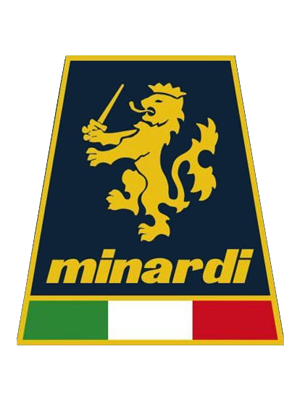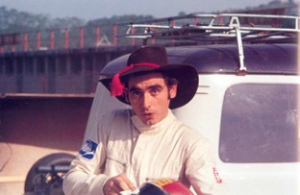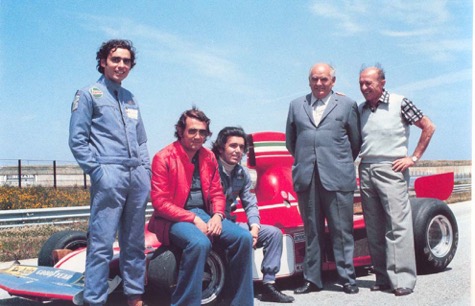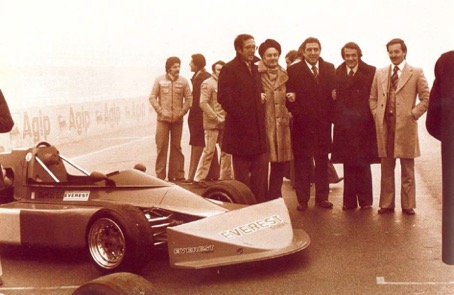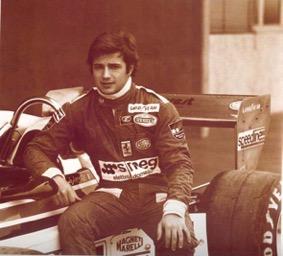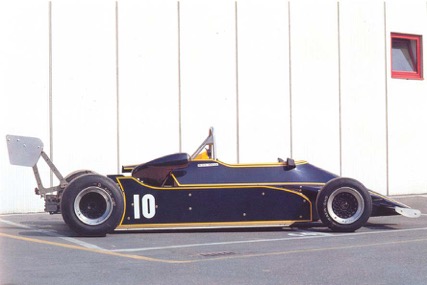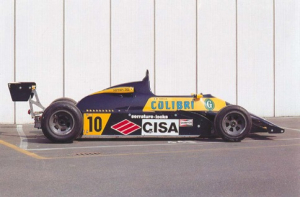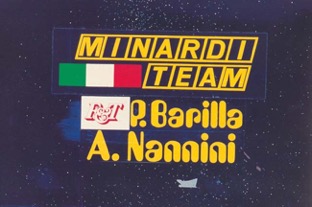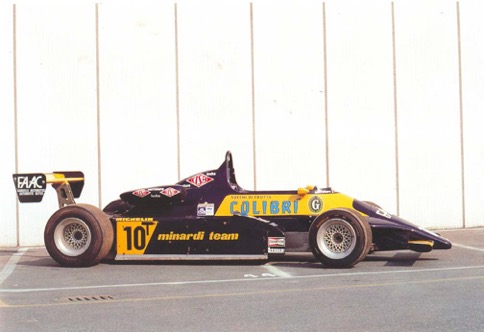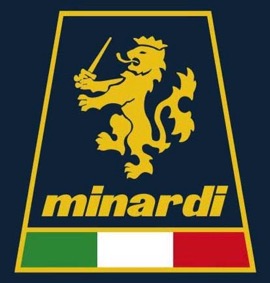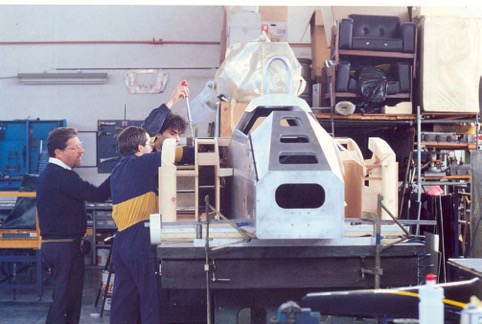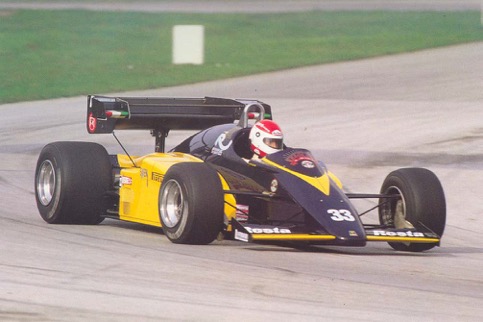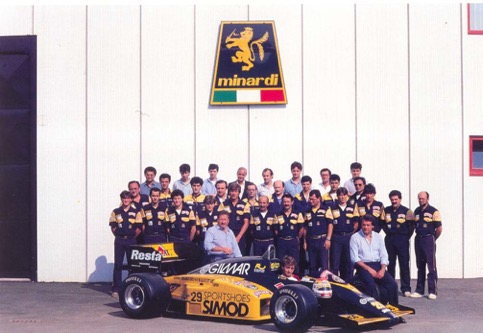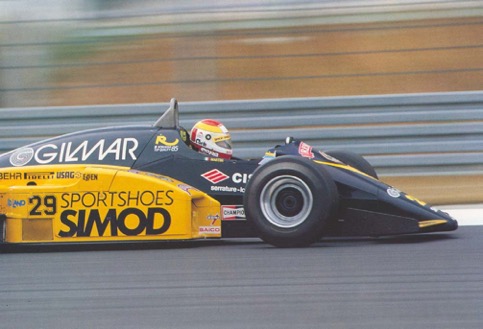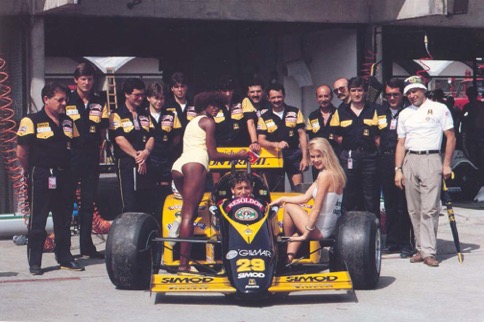From the beginning to April 5, 1985 when a dream came true.
The start of a great passion
The pairing of Gian Carlo Minardi and Automobiles has lasted sixty years, from that now long ago 18 September, 1949 when Giovanni Minardi and Elena Marina’s first born came into the world.
After graduating in accounting in 1966 Gian Carlo began to work with his mother managing the family company, the “Giuseppe Minardi & F.lli” (Giuseppe Minardi & Brothers) FIAT dealership founded in 1927 by Giuseppe, Vincenzo and Luigi Minardi. Right from the start it became clear that the intentions of the young man from Faenza were very different and in 1967 he took part in rallies at the wheel of a “124” but after a spectacular accident while he was driving a Formula 850 – luckily with no consequences – he decided to abandon the idea of becoming a great racing driver and so dedicated himself to the family and on April 11, 1970 he married Mara and from this union Giovanni Minardi was born on November 6, 1974.
Giancarlo Martini – Photo taken from: Minardi Team F1 byStefano Pasini, Pub. C.E.L.I. Sport
In 1972 Dr. Alteo Dolcini the Secretary General of the Faenza Local Council at the time and manager of the Passatore Company summoned the twenty five year old Minardi to place him beside Giovanni Liverani and his son Franco in the management of the Scuderia del Passatore team.
Gian Carlo accepted this important position immediately and quickly went to work despite his commitments in the family’s dealership. Gian Carlo Minardi’s first decision was to start in the “middle school” of racing, F.Italia, the competition characterized by tubular frame chassis, wheels and engines – FIAT 1800 – which were the same in all the teams. In any case, at the same time he continued the Scuderia del Passatore’s commitment in the F.3 championship as well, with Massimo Ciccozzi at the wheel of the Alfa Romeo powered Brabham.
The first Gian Carlo Minardi “tagged” driver was Giancarlo Martini and the result of the new management was not long in coming with Martini who finished the F.Italia National Championship in second place.
The following season was the consecration for Martini and the team led by Minardi which won the Championship achieving 14 wins in a season made up of 22 rounds – 10 wins for Martini and 3 for team mate Leoni – and 6 second places. These important results drew the eye of Commendatore Angelo Gallignani, the patron of the Everest accessories company, who decided to support the Scuderia del Passatore with a large sponsorship for the following season. This new collaboration allowed Gian Carlo Minardi and the team to make the leap of quality and to register in the F.2 championship as well.
In fact, the F.Italia season did not go as well as expected despite a great start by the promising young driver Lamberto Leoni when, after a black flag, the title went to Brancatelli.
Giancarlo Martini, Gian Carlo Minardi, Lamberto Leoni, grandfather Martini, Giovanni Liverani with the Ferrari B3 at Misano – Taken from: Minardi Team F1 by Stefano Pasini, Pub. C.E.L.I. Sport
1974 was a very important year for Gian Carlo Minardi’s career; the results had been noticed by Enzo Ferrari who in November of that year summoned the young man from Faenza to get to know him personally and the entrust him with his F.1 car to allow promising young Italian drivers to gather experience. In addition to the use of the Ferrari F.1 B3 to test the young recruits on the circuits of Santa Monica in Misano and “Dino Ferrari” in Imola. The agreement between the “Drake” and Gian Carlo Minardi included also the possibility of using the Fiorano track for the Scuderia del Passatore’s tests with drivers Serblin and Leoni.
Therefore 1975 became a very demanding season for Minardi who, in addition to having to manage the Scuderia involved in the F.Italia National Championship and the European F.2 Championship, also had his hands on the Ferrari B3 for major tests at the Misano track, all with the same operational structure.
As if this were not enough, Gian Carlo also continued to work six hours a day at the family dealership.
The flag bearers for the new F.2 season were Leoni and Martini who were entrusted with the March racing car powered by the German 4 cylinder BMW engine. The season soon began positively with good third and sixth places in Thruxton with the usual Martini. Unfortunately, as the season progressed the results started to drop and many drivers took to the wheel of the March next to the always fast Giancarlo Martini.
The presentaiton of the Scuderia del Passatore in 1975 From left to right: the engineerMauro Forghieri, Ezio Pirazzini, Dr. Gozzi, Gian Carlo Minardi, Maurizio Flammini. – Photo taken from: Minardi Team F1 by Stefano Pasini, Pub. C.E.L.I. Sport
After the highs and lows of the previous season, 1976 was the year of the new consecration of the Scuderia del Passatore and Giancarlo who went on to win the Italian F.2 Championship at the wheel of the March-BMW. After these successes Gallignani decided to increase his support and so the team was named “Scuderia Everest S.r.l”.
In 1977 the good results put on show by the young Italian drivers convinced Gian Carlo Minardi to enter Scuderia Everest in the F.2 Championship and to therefore put under contract the rivers Gianfranco Brancatelli and Lamberto Leoni, entrusting them with the racing car with the RALT chassis and powered by the powerful 2 litre 6 cylinder engines produced by the Company with the Prancing Horse called “Dino”. Also on the starting grid was a certain Riccardo Patrese who, as the recent winner of the European F.3 title, had signed a contract with Trivellato. In any case, despite highs and lows the season ended positively.
Elio De Angeli – Photo taken from: Minardi Team F1 by Stefano Pasini, Pub. C.E.L.I. Sport
New year, new racing cars and new drivers.
In 1978 the team from Faenza was once more involved in the F.2 Championship but this time with two Chevron racing cars powered by two different engines: a Ferrari for Elio De Angelis and a BMW for Michelangel Guerra. The disagreements with De Angelis over the performance of the Ferrari engine caused a lot of arguments which ended with the driver being left on foot for the Rouen grand prix. The seat left free by De Angelis was then taken by Guerra for the rest of the season while the second car was entrusted to a certain Clay Regazzoni for some races.
Guerra with the March-BMW alongside drivers including Clay Regazzoni and Ferrante Ponti.
We are now very close to the major change of direction for Gian Carlo Minardi and the birth of the Minardi legend which excited millions of fans spread around the world that followed his adventures from F.2 up to the grand debut in the F1 circus… but this is another story.
The Team is born… the legend of Minardi begins
From 1972 up to that moment-we are in 1979- Gian Carlo Minardi had managed teams and racing cars which bore the names of other owners: first the Scuderia del Passatore and then the Scuderia Everest S.r.l.
The situation changed drastically however in 1980 following the end of the sponsorship by Angelo Gallignani. In fact, Gian Carlo Minardi decided to gather together all the legacy of the teams he had managed up to the day before to give life to his own team and so the Minardi Team was born.
Gian Carlo Minardi decided to make changes within the structure of his new team. He summoned the engineers Franco and Giacomo Caliri and Luigi Marmiroli to his side, while a blue parallelogram divided into diamonds containing yellow letters and a tricolour flag on the lower left was chosen as the team’s logo.
Minardi G.M. 75 – Photo taken from: Minardi Team F1 by Stefano Pasini, Pub. C.E.L.I. Sport
The new Minardi Team had been brought together to participate in the European F.2 Championship and since the BMW powered March used up to then would not have been able to guarantee the proper competitiveness, Gian Carlo Minardi decided to take advantage of the experience of the “Fly Studio” created by Giacomo Caliri and Luigi Marmiroli to modify and improve the cars. Very soon they realized that the costs of such an operation in regards to the effective gain in terms of performance would have been too high for a small team with limited resources and so in the end Minardi decided to give life to the first racing car built completely from scratch. And so the G.M. 75 was born, the first racing car by Gian Carlo Minardi, designed by the engineers Caliri and Marmiroli, with which the Minardi Team faced its first race in 1980.
The new team’s organizational structure saw Gian Carlo Minardi in the role of director general and administrator, Caliri as the Minardi Team’s manager and Marmiroli as the technical director. On the drivers’ front, it was decided to entrust the G.M. 75 racing car to a single driver for the whole F.22 season, Michelangel Guerra who had already driven for Minardi during the period of Scuderia Everest. On the other hand, the second car was set up for a number of drivers during the season, such as Beppe Gabbiani and Bruno Corradi. In addition, motorcycle champion Johnny Cecotto made his debut for some races.
1980 was a year of apprenticeship because of the completely new racing car and for the team itself which in any case ended the season in 9th place on the ladder with Guerra.
Thanks to these results the following season could start with excellent auspices for putting into practice the experience acquired in its debut season. For the new adventure Gian Carlo Minardi resorted to his fame as a talent scout and put under contract Johnny Cecotto who had made a good impression with the team in yellow and blue and an as yet little known young driver: Michele Alboreto.
The new racing car, baptized the “Minardi Fly M 281” was once again signed by the constructive genius of Caliri – Marmiroli and powered by the tested German BMW engine prepared by Heini Mader.
The value of the new chassis was evident right from the times of the first tests on the track and the results in racing did not take long to arrive, also thanks to the great driving skills of Alboreto with third place in the Thruxton grand prix which was followed immediately by another, this time in Italy’s Pergusa circuit.
However, the excellent results on the track were in contrast to the financial hardship that the team was experiencing. In fact, no financer had come forward to support the efforts of the team from Faenza, so as to convince Gian Carlo Minardi to abandon the activity after yet another race without financing. Just as everything seemed definitively over, a famous industrialist stepped up to link his own brand to that of Minardi, this brought great faith back into the team which went immediately back to work to better prepare for the subsequent campaigns. The hard work and intense efforts were immediately rewarded thanks to the fantastic success of Michele Alboreto at the Misano Adriatico Circuit. It was the first win by the new born Minardi Team.
Minardi Fly M 281 – Photo taken from: Minardi Team F1 by Stefano Pasini, Pub. C.E.L.I. Sport
The great competitiveness of the driver from Milan however left his team mate unprepared who convinced that there was favouritism due to nationality, decided to leave the Minardi Team midway through the season to move to the Toleman Team where instead he found as his team mate a certain Brazilian whose name was Ayrton and surname was Senna.
For the rest of the season the wheel that Cecotto left free was taken by different drivers who were signed race by race. At the end of the season Michele Alboreto decided not to continue the collaboration with Minardi and to make the leapt of category.
The new Minardi Team logo with the names of the drivers- Photo taken from: Minardi Team F1 by Stefano Pasini, Pub. C.E.L.I. Sport
Therefore in the new year – we are in1982 – Gian Carlo decided to focus once again on talented young Italian drivers by signing Alessandro Nannini from F.Italia and Paolo Barilla. On the engine front Minardi once more turned to Enzo Ferrari to buy unused material from the “Dino F.2” project (engines, spare parts, designs and much more). After a few meetings the “Drake” agreed and prepared a truck full of precious material that Minardi took to the Minardi Team’s headquarters in Faenza where he went to work studying the way the best exploit every single piece. Together with his collaborators he decided to squeeze the most from the 6 cylinder engine from Maranello to give it greater power than that supplied by BMW. This task was entrusted to Bertoni Tonino di Piangipane (at the time chief mechanic and preparer of the engines and subsequently founder of the current BVM Team together with Vannini Bruno and Mazzotti Giuseppe) and the engineers Caliri and Marmiroli who managed to bring out 325HP compared to the 310/320 of the BMW. At this point the design of the two Minardi-Ferrari M 282s could begin.
While waiting for the racing cars to be finished the Minardi Team decided to start its third season in F.2 with the “Fly M 281B – BMW” with the agreement that once the Ferrari powered car was ready it would be entrusted to Paolo Barilla.
The tests of the new Minardi labelled cars began in February on the Fiorano track and the two young flag bearers quickly stood out, setting excellent times and even managing to beat the record for the category set by Michele Alboreto the year before.
The inexperience of the drivers, together with the growth of rivals of the calibre of Spirit-Honda, Maurer-BMW, TALT-Honda and Toleman were felt during the grands prix and this did not allow a strong and well organized Minardi Team to improve on the results achieved in 1981. This once again brought a very critical period due to new financial difficulties which had led to great debt. Luckily a new partner, Piero Mancini, came but in 1982 Luigi Marzolini decided to leave the Minardi Team to undertake an adventure in F.1 with Alfa Romeo and with him Giacomo Caliri also left. The project tied to the development of the Ferrari engine therefore had to be abandoned due to the lack of financial resources.
Fly M 281B – BMW – Photo taken from: Minardi Team F1 by Stefano Pasini, Pub. C.E.L.I. Sport
Despite the company’s hardships in 1983 Minardi decided to start the studies for the construction of a racing car with chassis made up of semi-finished materials. Therefore it went from riveted aluminium to the so-called “mixed structure” up to composite materials such as Carbon fibre and Kevlar.
The “M284” brought with it this very technology and was completed by the end of 1983, a season lived between highs and lows in the F.2 Championship.
The willingness to construct such a sophisticated car was only an excuse to acquire the experience necessary to make the great leap to Formula 1.
For some time Gian Carlo had only one thing in mind: to bring his Minardi Team into the highest category of automobile sport, despite being aware of all the difficulties such a choice would entail. For example, the Minardi Team did not have a multimillion dollar sponsor at hits back to cover the costs for producing the first F1 car made wholly in the Romagna. On the other hand, it must be considered that the team was then composed of 22 people, the costs were rising dramatically and new funds had to be found. Hence, in 1984 the decision was made to enter F.1 and the debut was scheduled for the following year, 1985.
The brand new Minardi Team logo designed by Gian Carlo Minardi
Furthermore, in those years the Minardi Team had also changed its logo in the light that the one used up till then was not suitable for fixing onto the nosecones. Gian Carlo therefore decided to take an old family coat of arms made up of a lion with a two pointed tail (which was also the symbol of the city of Faenza) and a green sword pointed down on a black background and started to modify it. The background then became blue, the yellow griffin with the tip of the blade pointed upwards, he added a tricolour underneath and all this was enclosed in a trapezium with the widest side at the bottom.
1985: The dream came true
In1984 Gian Carlo was therefore able to bring together a great professional legacy as Team Manager and his Minardi Team drew great attention to him, even though the results achieved up till then had not fully rewarded the efforts. Gian Carlo had already been thinking for some years on the great leap in category to Formula 1, to the world where great and powerful people had also encountered many hardships due to the high costs. However, this did not stop Minardi and he set the debut in the highest series for the following year and he decided to carry on despite the lack of a million dollar sponsor who could have financed the birth of the F1 car from Italy’s Romagna region. Supporters had to be found along the road, also because the Minardi Team was made up of 22 people, too many for F.2 but few for the adventure in F.1and hence new financers had to be found who were only interested in the highest category.
Thus in light of the coming debut Minardi decided to make Alfa Romeo an offer to take over its F.1 team that was not experiencing a particularly happy period due to poor sporting results and high management costs. Gian Carlo requested a meeting with Alfa Romeo’s then President Massacesi to show him the project in person who agreed initially to supply the engines. Following this agreement the constructor from Faenza threw his heart and soul intro preparing the new adventure by reorganizing the team. The Minardi Team’s first car which was already completed at the start of summer was characterized by a chassis in Aviolan sandwich with layers of carbon fibre and Kevlar, high air intakes to allow greater cooling and better placement of the radiators and by a triple rear wing with two lateral flaps and the pulsating heart was obviously the 8 cylinder Alfa Romeo engine. Obviously the car could only be christened “M184”. The car and the engine were entrusted to the talent of Alessandro Nannini who covered 2,000km. The cold shower came just when everything seemed ready to go and it was one of those pieces of news that nobody likes to hear. Massacesi advised Gian Carlo Minardi that the agreement had fallen through and therefore the M184 would not have Alfa Romeo engines for the new season.
A stage of the construction of the chassis of the “M 184 Alfa Romeo” – Photo taken from: Minardi Team F1 by Stefano Pasini, Pub. C.E.L.I. Sport
Alessandro Nannini in action- Photo taken from: Minardi Team F1 by Stefano Pasini, Pub. C.E.L.I. Sport
At this point , having understood that Alfa Romeo would not go back on its decision, Gian Carlo Minardi started to look around for another solution since it was already too late to take a step back and the season was about to start.
The choice therefore fell on the air cooled Ford-Cosworth engines which were much heavier and lower performing than the turbo of the producer from Milan. Hence the mechanics immediately went to work to modify the car that had to house the English engine. Further complicating the Minardi Team’s debut in F.1 was the question of a driver. The flag bearer for this new adventure should have been the every fast Alessandro Nannini who however did not yet have the super license needed to race in the highest championship. In fact, in order to get the license he should have gained a certain number of FIA points and at the end of the 1984 season he did not do so by single point.
Instead the driver who managed to obtain the super license with resounding wins and great performances was a certain Pierluigi Martini, nephew of Giancarlo Martini who had raced with Minardi during the years of the Scuderia del Passatore.
Therefore the new adventure could begin even if the idea of having to use the old Cosworth engines was unattractive.
At the same time, Gian Carlo Minardi’s partner Piero Mancini had set up his own company called “Motori Moderni” and called the engineer Carlo Chiti to work with him who went to work to design a new supercharged F.1 engine. This was a 1498.9 cc 90° V6 with two KKK 720HP turbo compressors that once finished was installed on the “M185”, the modified version of the first racing car to bear the Minardi Team name.
And so on April 7, 1985 the Minardi Team’s first F.1 season began in Brazil with the M185 that was still equipped with the Ford-Cosworth since it was decided to debut the new turbocharged Motor Moderni engine only at the third round, the San Marino Grand Prix on the historic Imola circuit.
Presentation of the new “M 185” in front of the new premises in via. Spallanzani, 2, Faenza. At the wheel Martini, Gian Carlo Minardi seated on the front tyre and engineer. Caliri on the rear – Photo taken from: Minardi Team F1 by Stefano Pasini, Pub. C.E.L.I. Sport
Pierluigi Martini in action with his “M 185 Motori Moderni” at the German Gp- Photo taken from: Minardi Team F1 by Stefano Pasini, Pub. C.E.L.I. Sport
“In those moments we ran on enthusiasm,” – remembered Gian Carlo Minardi with a smile – “It was the crowning moment of a dream come true, moreover in Brazil, in Rio de Janeiro which by its very nature is already joyful and lets you put up even better with the hardship and stress of the first grand prix. It was all new for us, we were all going in blind in that there was no technology, we were the new boys and we in the last pit with few spare parts and few mechanics – 10/11, driver included. I believe the photo is now historic that, if we compare with the last photo, we can see it was seven times less impressive. We went to Brazil of the thoughtlessness of the first time, where however it went we did well in that we were still lacking experience. We came from a very different reality, that of F.2, while we were now together with the true history of F.1, together with Ferrari, Tyrrel, Brabham, Lotus and Williams. Today I still l like to remember the morning of April 5, 1985 as the most beautiful moment of all Minardi’s history. That moment represents the crowning moment and at the same time the starting point of a dream”
The objective of the first season in the highest series was naturally to qualify the yellow and blue car number 29 for the grand prix and to bring it the most times possible to the finish in order to acquire the experience needed to continue to improve and grow. Martini then managed to qualify 15 times out of 16, placing 8th in Australia after starting in twenty third place on the grid just behind Ivan Capelli’s Tyrrel / Renault with a gap of only 0.7”, 11th in Germany and 12th in Belgium. It was precisely in Germany that the Minardi Team just missed out on its first world championship point when unfortunately Martini had to park his M185 number 29 at the side of the track after running out of fuel. It was only at Monte Carlo, the fourth round of the 1985 season, that the Minardi did not qualify, so ending its weekend early.
The Minardi Team at the Brazilian grand prix at the Rio track on 5 April 1985 – Photo taken from: Minardi Team F1 by Stefano Pasini, Pub. C.E.L.I. Sport
In any case, considering the problems tied to developing the car, the results achieved at the end of the debut season were more than satisfying. The ties with Ferrari were always very strong, so much so that Enzo Ferrari allowed the team from Faenza to test on the Fiorano track.
